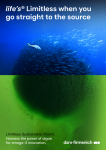Algatechnologies explores business beyond astaxanthin
business beyond astaxanthin. It is investigating opportunities to
derive other nutritional ingredients and biofuel from microalgae.
Algatechnologies began producing astaxanthin commercially in 2003 at its plant at Kibbutz Ketura, close to the beach resort Eilat and the southernmost point of Israel, where the country meets is neighbours Egypt, Jordan and Saudi Arabia.
A carotenoid thought to have an free radical fighting capacity worth 500 times that of vitamin E, astaxanthin has been studied for its role in eye health, skin health and potential to reduce the risk of serious conditions such as stroke.
It is produced by the Haematococcus pluvialis algae, which are naturally green but produce astaxanthin as a protective mechanism when stressed by sunlight.
At Algatechnologies, bright red-coloured algae courses through the unique and patented closed cultivation system, set against a desert backdrop where the hot, sunny and stable conditions mean the level of astaxanthin in the biomass is stable at between 3.5 to 4.3 per cent year round.
But while astaxanthin is the company's main product and will remain so, Amir Drory, director of product and application development said at a briefing at the kibbutz last week: "We don't want to be a one-product company".
To this end, Algatechnologies is looking at how it could derive other carotenoids, such as lutein and zeaxanthin, from microalgae.
It has some projects in the pipeline and is presently assessing the economic feasibility.
Crucially, astaxanthin is not being seen as a competitor to lutein or zeaxanthin in either the eye or skin health market, but rather as an adjunct to form a rich combination.
In particular the beauty from within segment is one of the fastest growing, with potential for astaxanthin to be sold as part of a cosmetics range.
Drory also said: "Omega-3 is a product we would like to isolate, and we hope to find a process that will be economically suitable."
The issue is to be cheaper or more competitive than fish oil.
The company would like to supply both DHA and EPA, but the two forms of fatty acid are not derived from the same creature.
Another challenge for the company is to find a way to tap the potential of the biomass residue once the astaxanthin has been extracted.
The residue contains around 35 per cent lipids and 65 per cent carbohydrates and proteins.
Algaetechnologies has yet to put these to use and Drory said the market is small at the moment.
But he said that the proteins could be used in animal feed, while the carbohydrates may find a role as a raw material for fermentation.
Moreover, there is potential to develop special polysaccharides from red or brown algae as a cosmetic ingredients - either alone or in collaboration with another company.
While nutraceutical ingredients represent value-added innovation, Algatechnologies is also looking to the other end of the scale by weighing up the potential for algae-derived biofuel.
The idea is to install cultivation facilities on the premises of power stations, and use carbon dioxide that they produce to nurture the algae.
The resulting biomass can then be used as a source of fuel.
In addition, the programme will help power stations reduce Co2 emissions, and therefore save them money in emissions fees.
There are around 17,000 power stations in Europe, the same number in the US, and rather less in Japan.
"If we can build for even a few of them, the market is huge," said Drory.
"The vision is to create a few thousand acres of microalgae production facilities."
To date, there has been interest from the US market, with a pilot plant in Greenfield, Arizona conducting tests on suitable algae strains and other factors.
Algatechnologies has already sold rights to the power station this plant is attached to, which will allow it to use the technology whenever it is ready.
Algaetechnologies was founded in 1998 and is 20 per cent owned by Kibbutz Ketera.
Eighty per cent is held by a private shareholder.
The company claims it is the largest supplier of astaxanthin for human applications (the ingredient is also used as a pigment for fish and crustaceans), and it expanded production by 160 per cent in 2006.
Jess Halliday visited Algatechnologies as part of a trip funded by the Israeli Export Institute.











